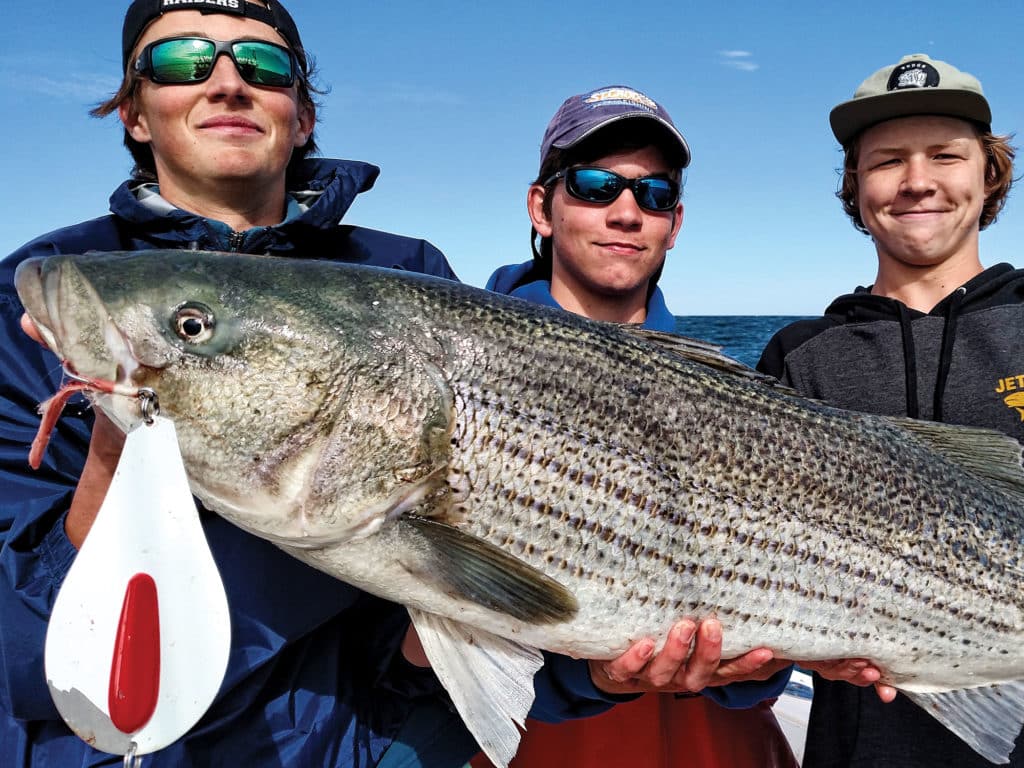
When the phone rang at 9pm the night before my charter, I knew it was bad news. But the cancelation took a positive turn: it meant that I had an opportunity to share the striped bass of a lifetime with my 16-year-old-son, Tommy, and his buddies.
These kids were already good fishermen and had caught striped bass, but never to the tune of the 30- to 50-pounders that I knew awaited us. Dreams of catching trophy-size bass have now become reality in Monmouth County, New Jersey, and northern Ocean County waters from May right on through the middle of July, thanks to the millions of adult menhaden, aka bunker, that pull in these trophy bass.
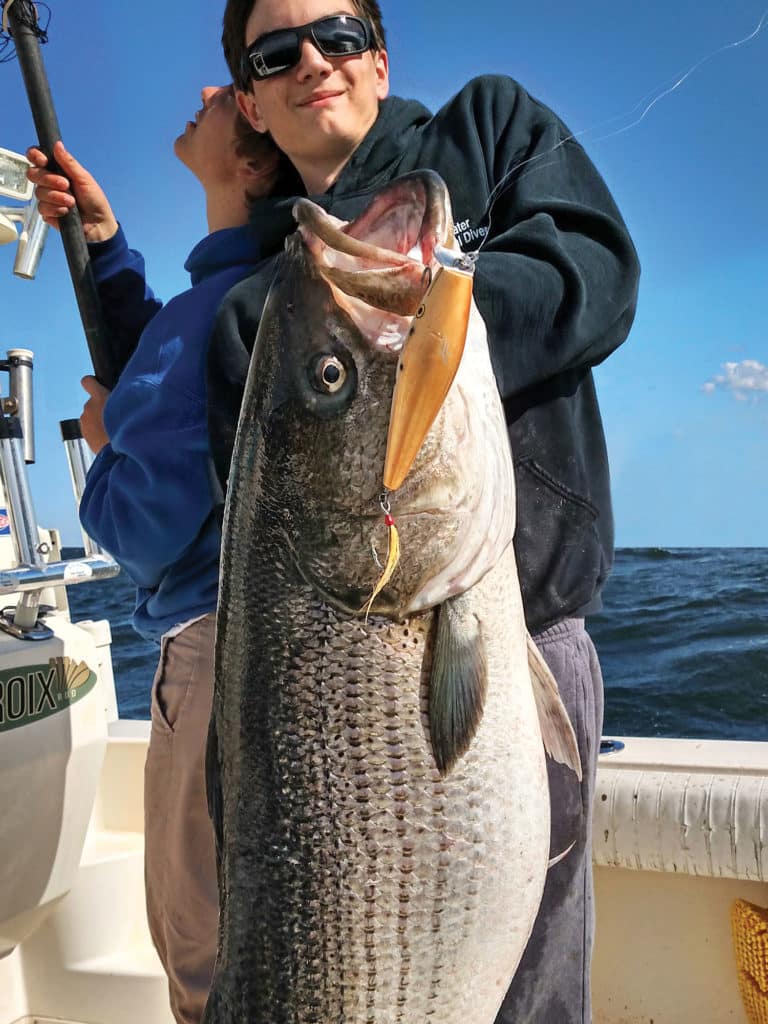
ACTIVE PODS
Prime time is always a predawn bite, so Tommy’s buddies arrived at 4 a.m., just as I had instructed. In a good year, hundreds of thousands of bunker school in an area only a few miles wide, so recognizing which pods have actively feeding bass in them is key. I gave the boys a quick lesson in what to look for. Bass thrashing and exploding on the bait is a no-brainer, I told them. And the pods that are flipping around without a care in the world are the ones that we are going to pass up. A subtler sign is when the pod balls up tightly, appears dark beneath the surface, and looks as though it’s shimmering. When this happens, the bass are right beneath the pod, ready to attack — so all eyes on deck.
SUCCESSFUL METHODS
As we broke the Manasquan Inlet, Tommy spotted the first active pod several hundred yards away. “Grab the snag rod!” I yelled. The snag rod should carry a weighted 5/0, 7/0 or 10/0 treble, which is cast into a bunker pod, allowed to sink, and then retrieved in quick jerks through the bait. A snagged bait is then free-lined and allowed to swim injured and sink. Then you wait for a bass to pick it up. Tommy, who had done this before, did a textbook job, and our first 35-pound bass came alongside for release.
Snagged bunker can also be live-lined by rehooking them on a single hook, which is a better option for catch-and-release. Place the hook a quarter-inch below and forward of the dorsal fin. An alternative to snagging is to throw a 10-foot, 1-inch mesh cast net. With one throw, I can fill my livewell with all the bunker I need for the day. Netting the bait keeps them alive much longer, ready to be pitched to an active pod.
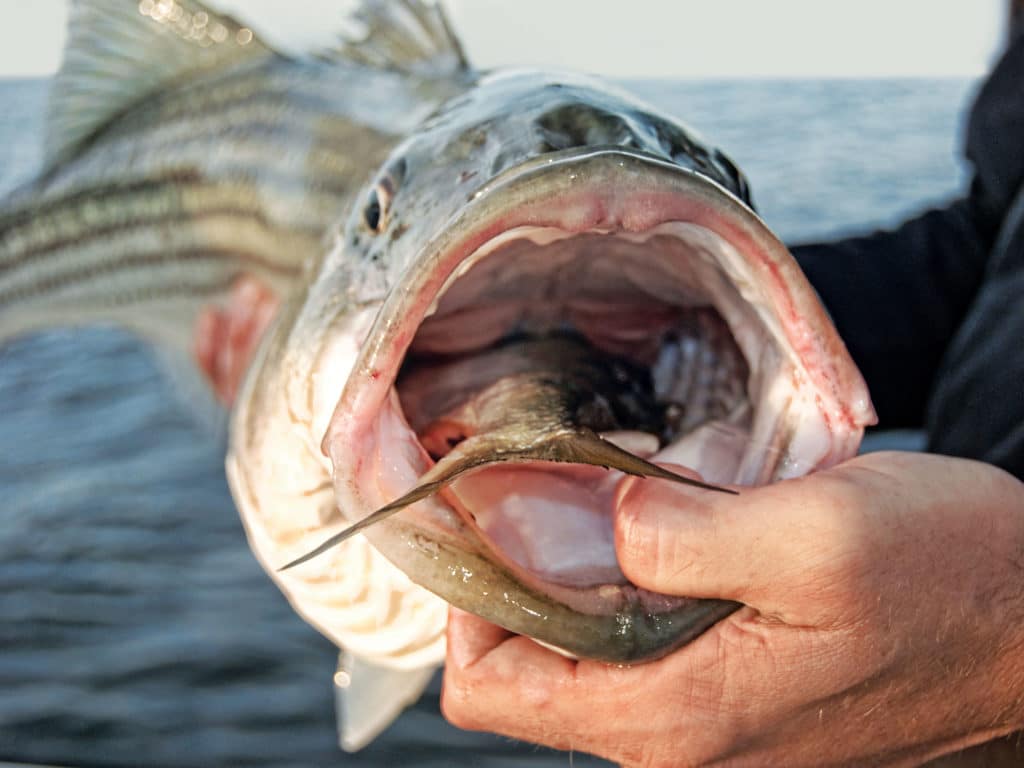
TROPHY TACTICS
All morning we found bass busting and feeding in bait pods. But we missed several fish when the boys pulled the trigger too quickly. When a bass picks up the bait, you have to be patient before you set the hook, I explained to them. Bass swallow a bunker headfirst, so after they pick it up, they have to turn it in their mouth. They do this on their first long run. I coached the boys to wait at least six seconds, until the runoff smoothed out, before setting the hook hard. Once they caught on, our catch rate climbed.
As the morning slipped away and the bite slowed, it came time for some advanced lessons. Casting a bait directly into the center of a pod creates what I call the doughnut hole, wherein the bunker scatter, leaving the cast bait by itself. This gets the attention of stripers. A second trick is trimming the tail of a bunker by three-quarters and casting it into a bait pod. With the tail cut, the bunker flutters around slowly, as if injured. Another option: hooking the bunker in the rear of the belly, which causes it to swim to the bottom, where the biggest bass lurk.
I showed the boys how dead bunker in the livewell can be fished effectively by hooking them through the bottom lip and out the snout, rather than in the dorsal. Cast out and allowed to drift away from the boat, the bunker flutter from side to side enticingly. You can also fish a chunk, normally a head, on a fish-finder rig when the bass hang deep and you are marking them on the sonar.
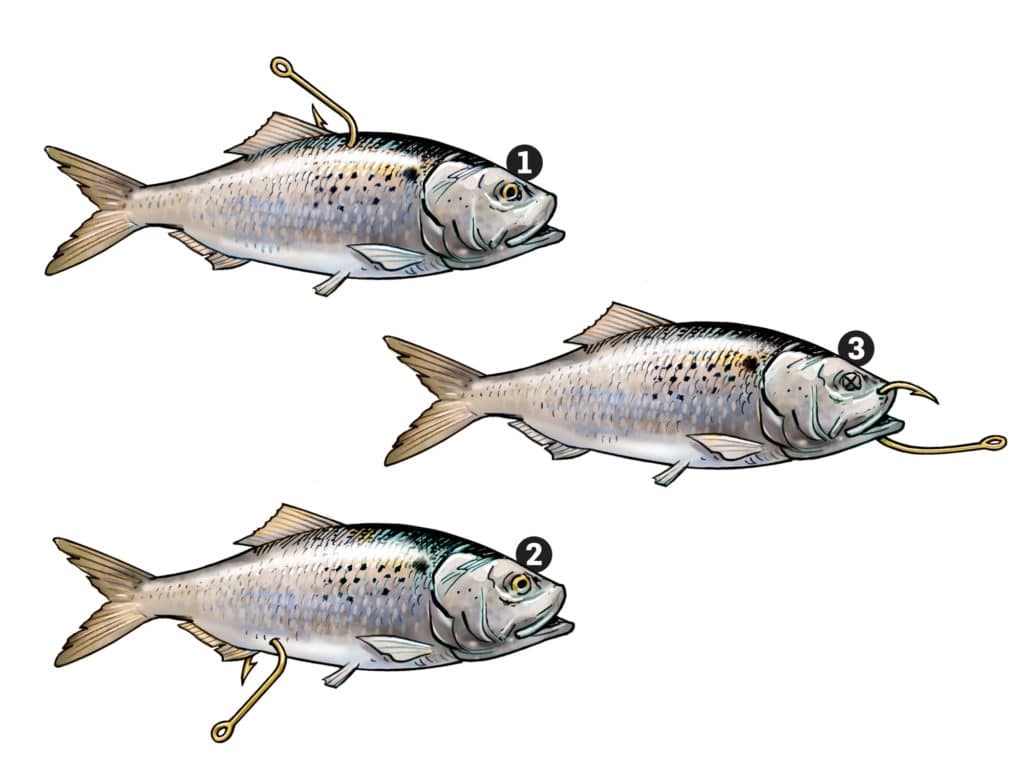
HOOK ‘EM RIGHT
Hook the live bunker on the back, about a quarter-inch forward of the dorsal fin, for free-lining.
AdvertisementWith the hook just ahead of the anal fin, a bunker swims toward the bottom, where the larger stripers lurk.
When liveys become scarce in your well, hook a dead one through the lower lip and snout and let it drift away.
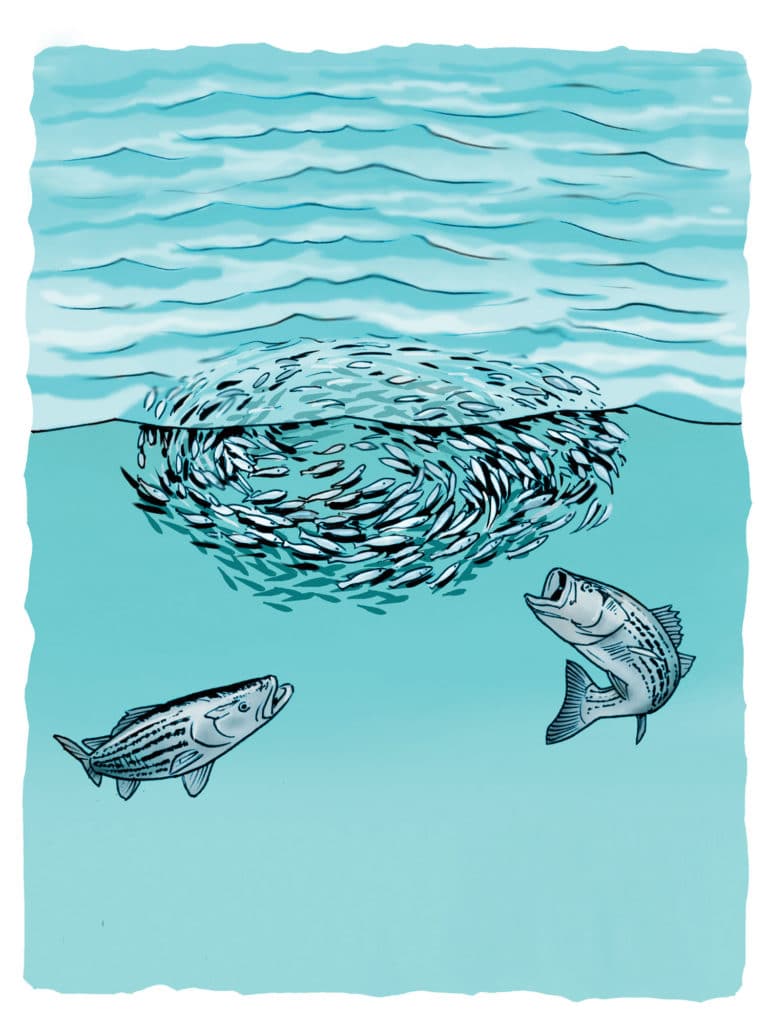
FLASH ‘N’ SLASH
When bunker schools congregate along a stretch of coast, pinpointing those actually under attack greatly increases your chances to score. If surface feeding isn’t evident, find a pod of tightly packed baitfish nervously shimmering underwater, a sign of stripers on the hunt directly below.
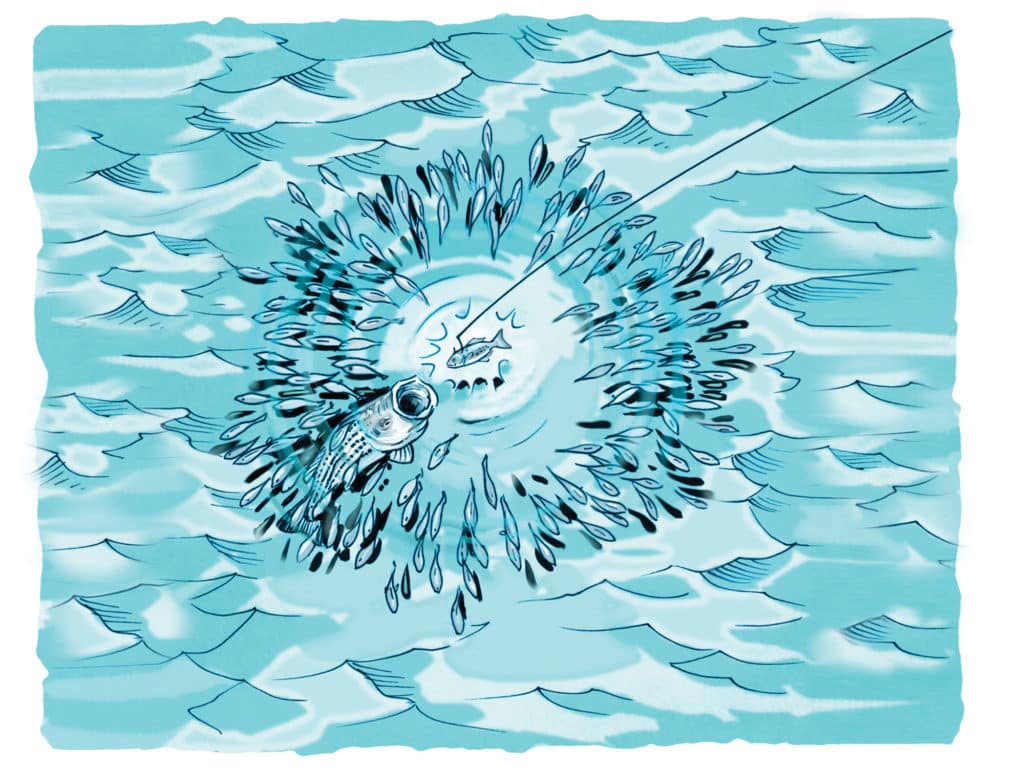
RING AROUND THE BUNKER
Hook a live bunker, drop it in the middle of a school, and you’ll see frantic menhaden dash away from your bait, interpreting the sudden splashdown as a predator attack. This “doughnut hole” attracts hungry stripers, which quickly key on the isolated bunker and pounce.
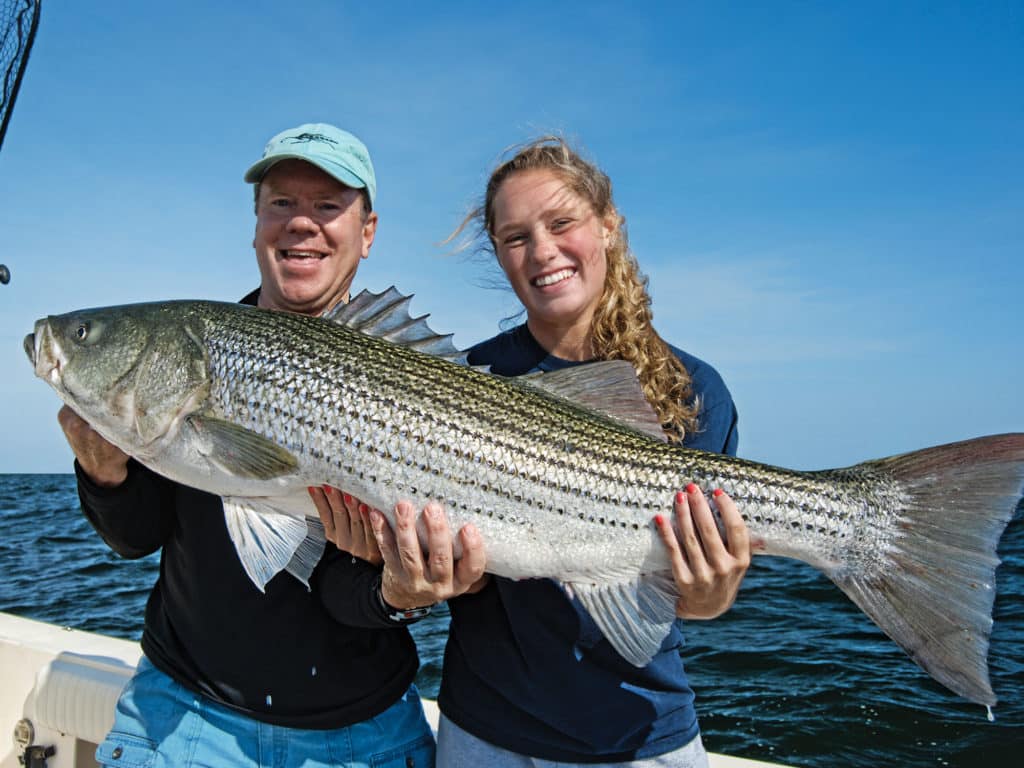
CLAIM TO FAME
The real trophy-bass accomplishment comes when you catch them on artificials such as lipped swimming plugs, surface poppers or pencil poppers. This trip ended up being one I will never forget, as Tommy and his buddy Max did just that. In the afternoon, the winds came up hard at 20 to 25 mph out of the northwest, and so did the big fish. When we saw them, Max grabbed a rod rigged with a JP Surfster swimming plug, and Tommy a rod rigged with a Lex Lures pencil, and both cast into a melee of busting bass. The result was a doubleheader: a 49-pound lifetime fish for Max and a 39-pounder for Tommy.
This part of New Jersey is known for having the best custom plug builders in the Northeast. My favorite custom swimmers are RV plugs, TB swimmers, Cyclone lures, Sunset Customs, Lefty lures, Skippies, T-Bone plugs and JP Surfsters. For poppers, I use M. Fischer poppers; for pencils, Lex Lures and Guides Secret Shore Catch series get the nod.
THE TROLLING GAME
We rounded out our day with a lesson in trolling. Tony Maja bunker spoons, Mojo lures or deep-diving plugs all take trophy bass and become especially effective on the big stripers when bunker pods are thin. I showed the boys my go-to trolling lure, a white No. 4 Tony Maja adult bunker spoon, paired with Maja’s custom 8-foot bunker-spoon rod. Trolling at 3.1 knots, it wasn’t long before the port rigger went off and Jack, one of Tommy’s buddies, got his own fish of a lifetime, a 40-pounder.









